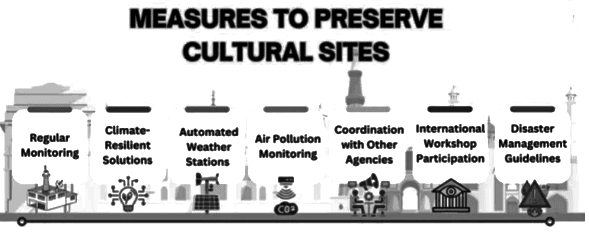UPSC Exam > UPSC Notes > PIB (Press Information Bureau) Summary > PIB Summary- 15th February, 2025
PIB Summary- 15th February, 2025 | PIB (Press Information Bureau) Summary - UPSC PDF Download
Conserving the Immortal Marks of Archaeological Sites
Context
India’s cultural heritage faces increasing threats from climate change, urbanization, and pollution.
The Archaeological Survey of India (ASI) is implementing conservation strategies to safeguard these historical treasures.
India’s Rich Cultural Heritage
- India is home to some of the most iconic cultural and archaeological treasures in the world.
- These include intricately carved temples, historic ruins, and religious sites spread across the country.
Threats from Climate Change
- Climate change and extreme weather patterns are putting these historical sites at risk.
- Factors such as rising sea levels, heatwaves, forest fires, torrential rains, and strong winds are accelerating damage.
- Both movable and immovable heritage is deteriorating due to these environmental challenges.
- Urgent intervention is necessary to protect these cultural landmarks and preserve India’s cultural identity.
Role of the Archaeological Survey of India (ASI)
- The ASI was established in 1861 to protect and maintain historical monuments and archaeological sites.
- It is responsible for conserving 3,698 nationally important sites.
- These sites are protected under legal acts such as the Ancient Monuments Preservation Act of 1904 and the Ancient Monuments and Archaeological Sites and Remains Act of 1958.
- ASI oversees a wide range of heritage, including temples, churches, mosques, tombs, forts, palaces, and prehistoric rock shelters.
- Every year, ASI prepares a conservation program to maintain and restore monuments while preserving their authenticity.
- Conservation efforts focus on structural stability, material preservation, and protection from environmental threats like pollution, encroachments, and natural disasters.
- ASI operates through 37 Circle offices and 1 Mini Circle office across India, coordinating conservation efforts and environmental protection measures.
Increased Funding for Monument Protection
- The Government has significantly increased funding for monument conservation.
- In 2020-21, ₹260.90 crores were allocated, with an expenditure of ₹260.83 crores.
- By 2023-24, this amount increased to ₹443.53 crores, reflecting a 70% rise in funding.
- The Government has enacted strict legal measures to prevent the commercialization and urban encroachment of heritage sites.
- The National Conservation Policy, 2014, provides guidelines for maintaining and conserving monuments.

Measures to Protect Cultural Sites from Climate Change
- ASI regularly monitors cultural heritage sites to assess climate change impacts.
- Climate-resilient solutions, such as scientific treatments and preservation techniques, are being adopted.
- Automated Weather Stations (AWS) have been installed in collaboration with ISRO to track weather conditions affecting monuments.
- Air pollution monitoring is conducted at key sites to control the impact of pollutants on heritage structures.
- ASI coordinates with other government agencies to develop strategies for protecting historical sites.
- The National Disaster Management Authority (NDMA) and ASI have formulated guidelines for risk assessment, preparedness, and recovery in case of disasters.

Conclusion
- Preserving India’s cultural heritage is a continuous process that requires coordinated efforts.
- ASI, in collaboration with other agencies, is actively working to monitor, protect, and conserve historical sites.
- By implementing environmental, legal, and security measures, the Government is ensuring that these historical treasures are safeguarded for future generations.
Question for PIB Summary- 15th February, 2025Try yourself: Which organization is responsible for conserving and maintaining historical monuments and archaeological sites in India?View Solution
The document PIB Summary- 15th February, 2025 | PIB (Press Information Bureau) Summary - UPSC is a part of the UPSC Course PIB (Press Information Bureau) Summary.
All you need of UPSC at this link: UPSC
Related Searches
















